Walking Tour of the Loop: Free Outdoor Art
A one-mile walk around downtown, a.k.a. the Loop, turns up some remarkable pieces of public art by an impressive roster of world-renowned artists. Take a peek at the map here, then head on out with these handy directions.
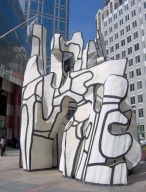
Starting from the Clark and Lake El stop, walk one block south on Clark to 100 W. Randolph, where you can peek beneath the arches of French Pop artist Jean Dubuffet's Monument with Standing Beast.
The 20,000-pound, 29-foot fiberglass statue has stood outside the reflective Thompson Center since 1984. Though its strictly black and white design could appear stark, the playful, puzzle-piece design results in a work that's both fun and interactive – kids and adults alike wander through its various entryways. Insider note: Dubuffet's art was inspired by artwork he saw when touring around mental institutions as a young man.
The 20,000-pound, 29-foot fiberglass statue has stood outside the reflective Thompson Center since 1984. Though its strictly black and white design could appear stark, the playful, puzzle-piece design results in a work that's both fun and interactive – kids and adults alike wander through its various entryways. Insider note: Dubuffet's art was inspired by artwork he saw when touring around mental institutions as a young man.
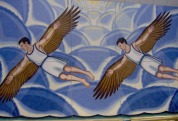
Continue west and hang a left at LaSalle, where half a block south on the right you'll find the radiant Arts and Science of the Ancient World: The Flight of Daedalus and Icarus arching over the entrance of the NBC Tower.
Completed in 1991, the Italian glass mosaic by School of the Art Institute alum Roger Brown depicts the classical scene of the father and son duo escaping the Minotaur's labyrinth. Insider note: The 54-foot panorama is part one of a series: take a quick shade break inside the lobby to see his Arts and Science of the Modern World: LaSalle Corridor with Holding Pattern.
Completed in 1991, the Italian glass mosaic by School of the Art Institute alum Roger Brown depicts the classical scene of the father and son duo escaping the Minotaur's labyrinth. Insider note: The 54-foot panorama is part one of a series: take a quick shade break inside the lobby to see his Arts and Science of the Modern World: LaSalle Corridor with Holding Pattern.
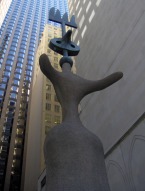
Cross the street and walk a block east on Washington to Miró's Chicago.
Tucked into the narrow Brunswick Plaza across from Daley Plaza, Joan Miró's 39-foot surrealist sculpture is often overlooked by walkers-by – but it shouldn't be. The Spanish artist shaped the soft curves and harsh angles of this unique piece with metal, concrete and tile in 1981, and it’s been a magnet for contemporary art lovers ever since. Insider note: it was originally called "The Sun, The Moon and One Star."
Tucked into the narrow Brunswick Plaza across from Daley Plaza, Joan Miró's 39-foot surrealist sculpture is often overlooked by walkers-by – but it shouldn't be. The Spanish artist shaped the soft curves and harsh angles of this unique piece with metal, concrete and tile in 1981, and it’s been a magnet for contemporary art lovers ever since. Insider note: it was originally called "The Sun, The Moon and One Star."
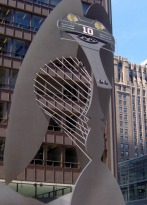
From here, you can't miss the giant modernist structure known as the Picasso, completed in 1967 and situated in a commanding spot in the middle of Daley Plaza.
An 82-year-old Pablo Picasso designed the 50-foot, 162-ton steel monument as a gift to the city. Its abstract qualities invite many interpretations, including the most popular: a jungle gym for kids. Insider note: the artist never saw the final work – it was built to spec by the U.S. Steel Works in Gary, Ind. based on a 42-inch model he had submitted.
An 82-year-old Pablo Picasso designed the 50-foot, 162-ton steel monument as a gift to the city. Its abstract qualities invite many interpretations, including the most popular: a jungle gym for kids. Insider note: the artist never saw the final work – it was built to spec by the U.S. Steel Works in Gary, Ind. based on a 42-inch model he had submitted.
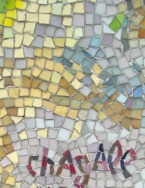
Take a right on Dearborn to the Chase Tower Plaza just south of Madison. Here you'll come across the Four Seasons, Marc Chagall’s glittering mosaic representing six Chicago scenes throughout the year.
Dedicated as a gift to the city in 1974, Chagall used thousands of bits of glass and stone – including Chicago brick – in 250 different colors to create this 70-foot long, 14-foot high and 10-foot wide cityscape. Insider note: Chagall designed the modernist mosaic in his studio in France, but continued to modify details after its installation because the city's skyline had changed drastically in the 30 years since he'd last seen it.
Dedicated as a gift to the city in 1974, Chagall used thousands of bits of glass and stone – including Chicago brick – in 250 different colors to create this 70-foot long, 14-foot high and 10-foot wide cityscape. Insider note: Chagall designed the modernist mosaic in his studio in France, but continued to modify details after its installation because the city's skyline had changed drastically in the 30 years since he'd last seen it.

Head south on Dearborn, and just past Adams you'll see the swooping Flamingo, which adds a much-needed splash of color to Federal Plaza.
American sculptor and artist Alexander Calder is known for his artistry with the stabile, a stationary sculpture that seems as animated as a mobile – an art form he’s credited with having invented in 1931. This deep red steel stabile was unveiled in 1974 and stands 53 feet tall. Insider note: Calder heralded Flamingo’s arrival to the Loop by carrying it in with a team of 40 horses and a circus parade.
American sculptor and artist Alexander Calder is known for his artistry with the stabile, a stationary sculpture that seems as animated as a mobile – an art form he’s credited with having invented in 1931. This deep red steel stabile was unveiled in 1974 and stands 53 feet tall. Insider note: Calder heralded Flamingo’s arrival to the Loop by carrying it in with a team of 40 horses and a circus parade.
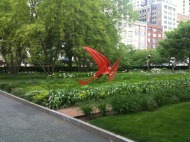
From there, hoof it three blocks east and one block north on Michigan Avenue to the Art Institute gardens. Of course, there’s a lot of art within the walls that you can see for a fee, but the lovely gardens on the north and south side of the main entrance are lovely, peaceful and free.
Behind a series of low fountains and a canopy of hawthorns in the South Garden is Lorado Taft's bronze Spirit of the Great Lakes Fountain (1913). The Illinois-born sculptor's allegorical work features five women who represent the Great Lakes.
Insider note: The water flows through the figures just the way it does through the Lakes themselves, beginning with the tallest woman – Lake Superior, which has the highest elevation – and continuing east at lower levels through each lake until it passes out into the St. Lawrence River.
In the quiet, shady North Garden (see photo), you’ll find Large Interior Form (1982), Henry Moore's abstract sculpture with his trademark hollows and smooth curves, Indiana-born David Smith's geometric, stainless steel Cubi VII (1963), and another red stabile by Alexander Calder, the whimsical Flying Dragon (1975).
Insider note: In 1951, English artist Henry Moore turned down a knighthood, worrying that he’d been seen as too much a part of the establishment.
Behind a series of low fountains and a canopy of hawthorns in the South Garden is Lorado Taft's bronze Spirit of the Great Lakes Fountain (1913). The Illinois-born sculptor's allegorical work features five women who represent the Great Lakes.
Insider note: The water flows through the figures just the way it does through the Lakes themselves, beginning with the tallest woman – Lake Superior, which has the highest elevation – and continuing east at lower levels through each lake until it passes out into the St. Lawrence River.
In the quiet, shady North Garden (see photo), you’ll find Large Interior Form (1982), Henry Moore's abstract sculpture with his trademark hollows and smooth curves, Indiana-born David Smith's geometric, stainless steel Cubi VII (1963), and another red stabile by Alexander Calder, the whimsical Flying Dragon (1975).
Insider note: In 1951, English artist Henry Moore turned down a knighthood, worrying that he’d been seen as too much a part of the establishment.